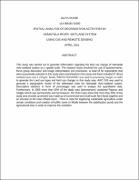Spatial analysis of Degradation activities in Namatala River- Wetland System Using Gis and Remote Sensing
Abstract
This study was carried out to generate information regarding the land use change of Namatala river-wetland system on a spatial scale. The research study involved the use of questionnaires, focus group discussion and image interpretation and procession. A total of 50 respondents that were purposively selected in this study were interviewed in this study and these included 47 direct wetland users and 3 villages’ heads. ERDAS IMAGING was used in processing images in order to generate the Land use types and land use changes in this study area, ARC GIS was used to generate a topographic model of the delineated units for Namatala river-wetland system. Descriptive statistics in form of percentages was used to analyse the quantitative data. Furthermore, in 2005 more than 50% of the study area (downstream) contained Papyrus and Sedges which was permanently wet but however, the 2014 maps show that more than 50% of the study area (mostly up stream) was made up of commercial and small scale farm lands together and an increase in the road infrastructure. .There is need for legalizing sustainable agriculture under certain conditions and creation of buffer zones in Mbale between the stabilization ponds and the agricultural zone in order to improve the condition.
Collections
- Thesis and Dissertations [209]

